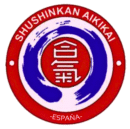Requirements for graduation
Aikido doesn't have competitions or tournaments. Our school conducts annual evaluations for graduation. The grading system allows for an assessment of each student's learning level, while exam preparation generates internal changes in both the students taking the exam and their peers, in relation to the demands they must meet. This also develops a sense of effort and concentration, in addition to fostering non-competitive collaboration and assistance.
Although assessment is ongoing, preparing for and taking exams and changing grades become an incentive, a short-term goal for each individual.
Preparation for the presentation contributes to the deepening and acquisition of knowledge, as well as to personal and group growth and improvement. With the collaboration of their peers, each student works to develop their own perception and ways of resolving the difficulties posed by the practice of Aikido and, consequently, by life itself.
The grading system allows for the determination of each student's practice time and learning level, and also serves as support for those newer to their journey. It is not a system of power or subservience toward those with a lower grading, but rather one of service and collaboration with those less experienced. The higher the grading, the greater the responsibility toward the dojo and their fellow students.
Kyu ranks are awarded by Shushinkan Aikikai, whose current president is José Luis Caló, while Dan (black belt) ranks are awarded by the Aikikai Foundation (Hombu Dojo – Tokyo, Japan), whose current president is Doshu Ueshiba Moriteru.
Theoretical knowledge: What is Aikido? Who is O-Sensei? What is a Dojo? Who was Yamada Yoshimitsu Sensei? What is Dojo Etiquette or Rules? Examples: What is the role of Nage? What is the role of Uke? What is Ma Ai?
Rokukyu (6°Kyu)
Gokyu (5° kyu)
40 days of practice
50 days of practice from 6th kyu
Postures: Tachirei – Hanmi (Migi, hidari) – Seiza – Zarei – Kiza – Shikko
Movements (Tai Sabaki): Irimi – Tenkan – Irimitenkan – Kokyu Undo – Ikkyo Undo – Funakogi Undo (rowing exercise) – Katatedori gyakuhanmi Tai no henko (tenkan)
Katatedori Gyakuhanmi:
Sumiotoshi
Tenchinage
Kokyuho
Uchikaitennage
Katatedori Aihanmi:
Iriminage
Kotegaeshi
Ikkyo
Shihonage
Kokyu Doza – Zagi kokyuho
Requested by the Examiner
Attacks: Katatedori Gyakuhanmi – Katatedori Aihanmi – Ryotedori – Shomenuchi
Ukemis: Ushiro ukemi (squat, standing) – Yoko Ukemi (side fall) – Ushiro Yokokaiten ukemi
Movements (tai sabaki):
Kaiten, Irimikaiten, tenshin
Techniques:
Shomenuchi
Iriminage
Ikkyo (Omote y Ura)
Katatedori Gyakuhanmi
Shihonage (Omote y Ura)
Sotokaitenage
Ryotedori
Tenchinage
Tsuki
Kotegaeshi (Tenkan)
Ushiro Tekubitori
Kotegaeshi
Katatetori Aihanmi
Udekimenage
Morotetori
Kokyuho (Omote y Ura)
Ushiro Katadori Kokyuho (walking)
Attacks and Ukemi: Tsuki – Yokomenuchi – Ushiro tekubitori – Maekaiten and Ushirokaiten ukemi
Kokyu Doza – Zagi kokyuho
Requested by the Examiner
Yonkyu (4° kyu)
Sankyu (3° kyu)
80 days of practice from 5th kyu
100 days of practice from 4th kyu
Katatedori Gyakuhanmi Ikkyo
Shomenuchi Nikkyo (Omote y Ura)
Yokomenuchi Shihonage (Omote y Ura)
Tsuki Iriminage
Tsuki Kaitennage
Ushiro Tekubitori Sankyo (Omote y Ura)
Ushiro Ryokatatori Kotegaeshi
Morotetori Kokyunage
Suwariwaza:
Shomenuchi Ikkyo (Omote y Ura)
Katatori Nikyo (Omote y Ura)
Katatori Sankyo (Omote y Ura)
Hanmi-Handachi waza:
Katatedori gyakuhanmi kokyunage
Ukemi: Mae Yokokaiten ukemi
Kokyu Doza – Zagi kokyuho
Requested by the Examiner
Bokken no suburi:
Sichi Bokken No Suburu: 1 a 3
Jo No Suburi:
Serie Tsuki 1 a 5: Choku Tsuki, Kaeshi Tsuki, Ushiro Tsuki, Tsuki Gedan Gaeshi, Tsuki Jodan Gaeshi Uchi
Yokomenuchi:
Iriminage (dos maneras)
Kotegaeshi (omote y ura)
Shomenuchi:
kaitennage (uchi y soto mawari)
Sankyo (omote & ura)
Ushiro Ryokatatori Sankyo (omote & ura)
Morotetori Iriminage (dos maneras)
Katatori menuchi kotegaeshi
Suwari Waza:
Shomenuchi Iriminage
Shomenuchi Nikkyo (omote & ura)
Hanmi-Handachi waza:
Katatedori Shihonage (omote & ura)
Katatedori Kaitenage (uchi & soto mawari)
Kokyu Doza – Zagi kokyuho
Ushiro maekaiten ukemi
Requested by the examiner
Bokken no suburi
Sichi bokken no suburi (1 a 7)
Jo no suburi
Uchikomi (1 a 3 shomen uchikomi, renzoku uchikomi, menuchi gedan gaeshi)
Nikyu (2° kyu)
Ikyu (1er. kyu)
150 days of practice from 3rd kyu
200 days of practice from 2nd kyu
Shomenuchi
Shihonage (omote y ura)
Kotegaeshi (O y U)
Yokomenuchi
Kaitennage
Gokyo
Ushiro ryotekubitori
Kaitennage
Shihonage (omote y ura)
Jujinage
Ushiro Tekubitori Kubishime sankyo (omote y ura)
Ushiro Kubishime Koshinage
Morotetori Nikkyo (omote y ura)
Tsuki kokyuho (omote y ura)
Katatori menuchi shihonage
Suwariwaza:
Tsuki kotegaeshi
Tsuki iriminage
Hanmi-Handachi wasa:
Katatetori kokyuho
Katatetori Nikkyo (omote y ura)
Shomenuchi Iriminage
Yokomenuchi Kotegaeshi
Ushiro ryokatatori kokyunage
Tachiwaza Randori – 2 attackers
Ushiro mae yokokaiten ukemi
Kokyu Doza – Zagi kokyuho
Requested by the examiner
Jo no suburi :
Serie Uchikomi: menuchi ushiro tsuki, gyaku yokomenuchi ushiro tsuki (4 y 5)
Serie Katate: katate gedan gaeshi uchi (gedan katate uchi), katate toma uchi, katate hachi no ji gaeshi (11 a 13)
Sanju ichi Jo no kata
Bokken no suburi:
Hachi bokken no suburi (1 a 4)
Katatori Menuchi – five techniques
Yokomenuchi – five techniques
Morotetori – five techniques
Shomenuchi – five techniques
Ryotetori – five techniques
Tsuki – five techniques
Ushiro tekubitori – five techniques
Koshinage – five techniques
Tantotori
Hami-Handachi
Ushiro Waza – five techniques
suwari waza
Shomenuchi – three techniques
tsuki – three techniques
randori – 3 attackers
Kokyu Doza – Zagi Kokyuho
Ushiro otoshi ukemi
Order by examiner
Jo no suburi
Hasso gaeshi: hasso gaeshi uchi, hasso gaeshi tsuki, hasso gaeshi ushiro tsuki, hasso gaeshi ushiro uchi, hasso gaeshi ushiro barai (14 a 18)
Nagare: hidari nagare gaeshi ipponme, hidari nagare gaeshi nihonme, migi nagare gaeshi tsuki (19a, 19b y 20)
Jusan Jo no kata
Jo nage
Kumi Jo
Bokken no suburi:
Hachi bokken no suburi (1 a 8)
Kumi tachi
